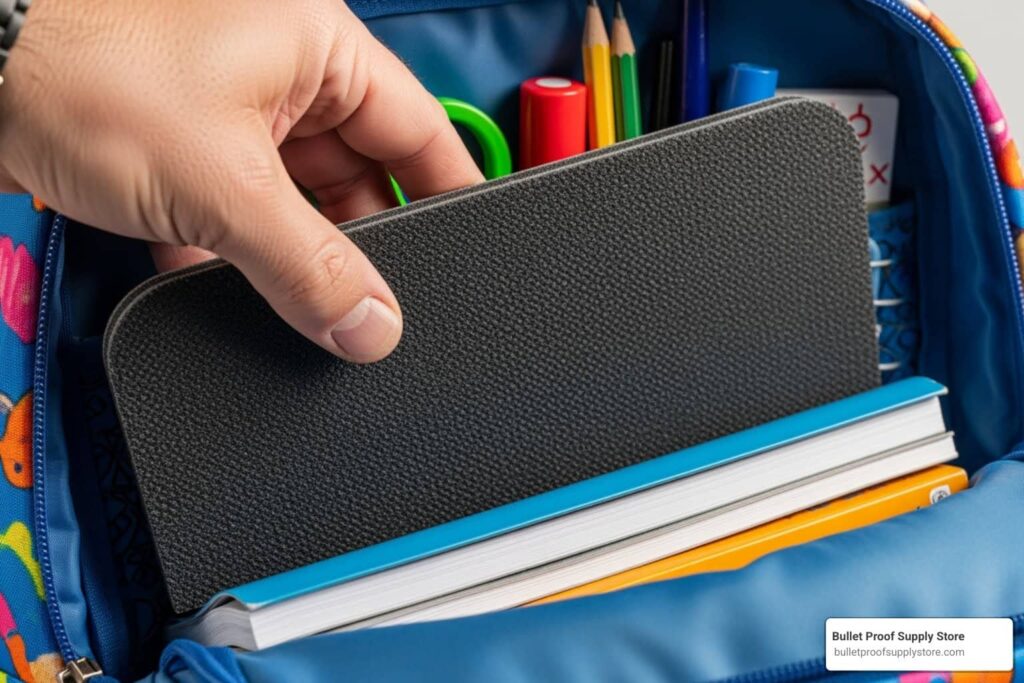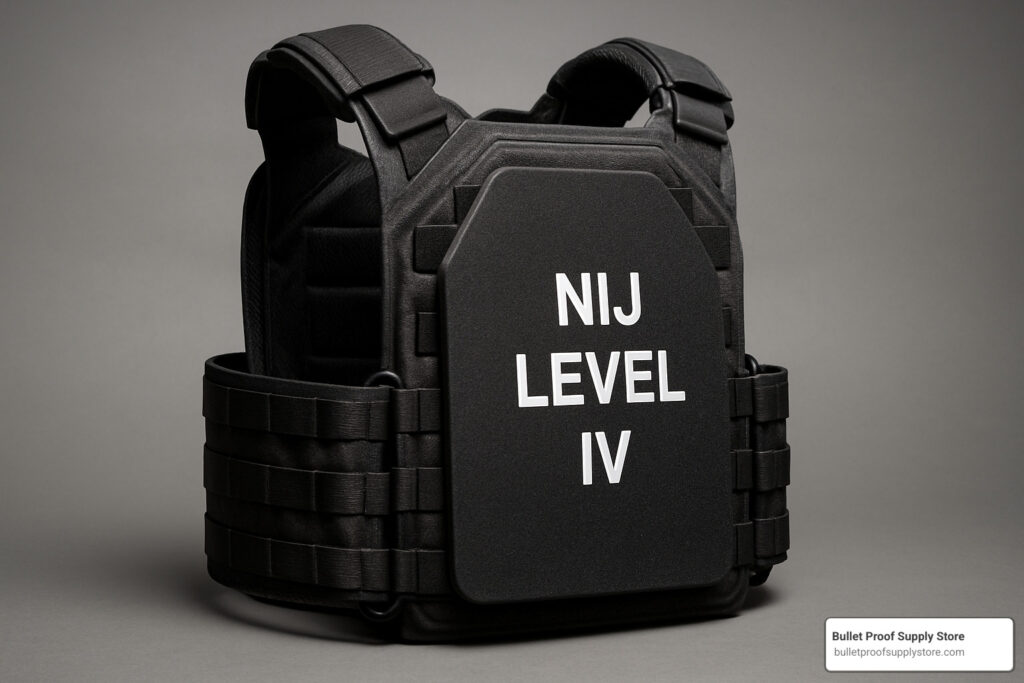Personal safety is no joke. Nothing is more vital than choosing gear designed to protect and live up to the highest standards. Understanding Bulletproof Vest Testing and Certification Standards isn’t just for the technically minded; it’s about guaranteeing that the lifesaving equipment meets strict guidelines for performance under pressure. Bulletproof vests, offered by the Bullet Proof Supply Store, are not just fabrics sewn together; they are shields in the battle against unforeseen threats.
The path to trusting in these vests begins with a set of rigorous tests defined by the National Institute of Justice, or NIJ. Think of the NIJ as the guardian of armor standards, setting forth the protocols that vests must pass to be deemed trustworthy. The testing process is detailed and thorough, simulating real-world threats to guarantee that when a vest says it’s bulletproof, it lives up to that promise.
As we prepare to delve into the “What Are Bulletproof Vest Testing and Certification Standards?” section, consider this: the standards are not just a checklist. They are assurances that the vest you strap on will stand between you and harm’s way. With lives in the balance, understanding these standards is not just about knowledge but about peace of mind. Let’s unravel the meticulous process that bulletproof vests undergo and decode the NIJ standards that benchmark their safety.
What Are Bulletproof Vest Testing and Certification Standards?
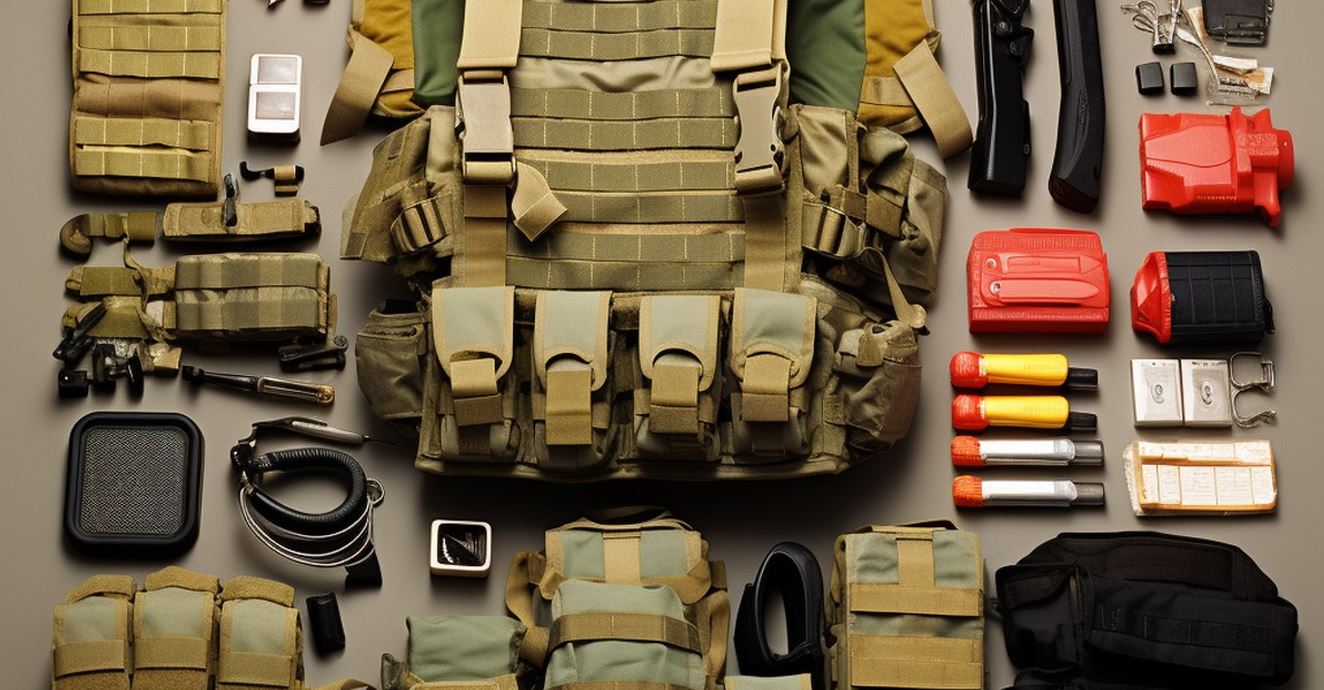
Bulletproof vests are becoming a crucial part of our everyday safety, and testing plus certification standards make sure these vests can truly protect us. These benchmarks are like tough exams that vests must pass to prove they’re up to snuff. The National Institute of Justice, or NIJ for short, sets these tough rules in the US.
- Testing: It’s like a stress test for vests to see if they can take a hit and still keep you safe.
- Certification: This is the thumbs-up that a vest gets if it passes the tests. It’s a badge of honor showing the vest is reliable.
- Key Organizations: The NIJ is the big player here. They’re the ones who say what’s safe and what’s not in the world of body armor.
Bulletproof vest standards are no joke. They ensure that when the chips are down, your vest has your back. These standards act as a promise that the vest you purchased will hold up against specific threats.
Now, let’s break down what goes into these standards:
- Levels of Protection: The NIJ has different levels, like IIIA, which stops big handgun bullets, all the way up to level IV, which can take a hit from a rifle.
- Testing Methods: They don’t just shoot the vests once and call it a day. They put them through the wringer with multiple shots and different angles.
- Materials: They check what the vest is made of, because the stuff that stops a BB gun is different from what you’d need for a .44 Magnum.
Here’s a table showing the different NIJ levels and what they can handle:
| NIJ Level | Protection Against |
| II | 9mm and .357 Magnum |
| IIIA | .357 SIG and .44 Magnum |
| III | Rifles up to 7.62mm |
| IV | IV Armor-piercing rifle rounds |
These tests aren’t done just once. They repeat them in hot, cold, and wet conditions to mimic the real world. It’s like they’re saying, “If this vest can take it here, it can take it anywhere.”
And it’s not just about stopping bullets. The vests also need to be comfy and not too bulky, so you can move around in them.
If you’re in the market for a vest, you’ll want to check for the NIJ’s stamp of approval. It’s like a green light saying, “This vest has your back.” You can learn more about how these tests go down and what each level means by checking out this in-depth guide.
Now, thinking ahead, you might wonder why all this testing and certifying even matters. Imagine you’re in a tough spot, and the only thing between you and danger is your vest. You’ll be grateful for those standards that make sure your vest can take the heat. It’s all about trust – knowing your gear won’t let you down when it really counts.
Why Are Testing and Certification Standards Essential?
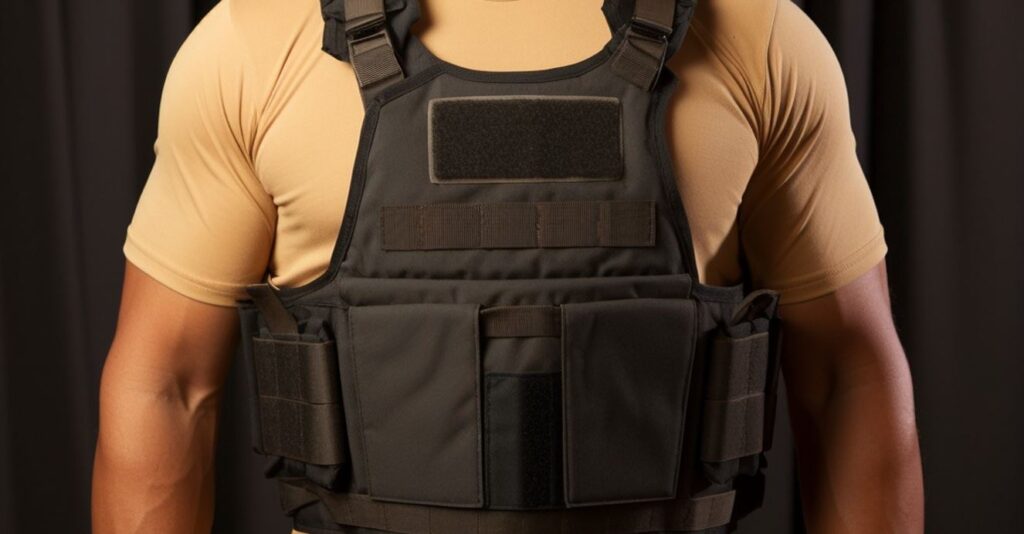
Body armor comes with specific ratings and some are vastly different than others with can be confusing right? Well-testing and certification standards are the backbone of safety gear. They’re not just fancy stickers on a label. These standards are the heroes behind the scenes, ensuring that the gear you trust with your life does what it promises. Let’s peel back the curtain on why these standards are more than just technical jargon.
Safety Assurance for Users
Imagine stepping into a bulletproof vest without knowing if it could stop a rubber band, let alone a bullet. That’s where standards like NIJ come in. They are the professional grading system we use to measure the strength of body armor. With these benchmarks, users can breathe easy, knowing their gear has been pushed to the limits and came out on top. It’s like having a superhero’s shield – you know it won’t let you down when it matters most.
Quality Consistency Across the Board
Quality can’t be a game of roulette, especially when lives are on the line. Manufacturers stick to these standards to ensure every piece of armor is a twin to the last. It’s a way of offering customers some reliability. When body armor meets established standards, you get the same top-grade protection, whether it’s your first purchase or your hundredth.
Building Trust and Confidence
Trust isn’t given; it’s earned. Certification standards are how body armor earns that trust. When you see that certification seal, it’s a silent nod from the manufacturer saying, “We’ve got your back.”
Key Benefits of Certification Standards:
– Peace of Mind: Knowing your gear meets the gold standard.
– Reliability: Consistent protection every time, with no surprises.
– Trust: A certified vest is a trusted vest…period!
Here’s a quick look at what a bulletproof vest goes through before it earns its stripes:
Impact on Vest
| Test Type | Description | Performance |
| Penetration Test | Bullets are fired at the vest to see if they get through | Ensures bullets are stopped |
| Impact Test | Measures the force felt behind the vest | Reduces trauma to the wearer |
| Wear and Tear | Simulates extended use to test durability | Guarantees long-term safety |
And remember, that sleek bulletproof vest from Bullet Proof Supply Store didn’t just look good on a mannequin. It went through hell and back to earn the right to guard your life. This is certainly food for thought next time you suit up.
Going forward, let’s take a peek at how these vests go from a roll of fabric to a shield against danger. You’ll discover the secrets behind the scenes, the tests that turn a vest from ordinary to extraordinary. Just imagine the intricate dance between machine and material that ends with the birth of a lifesaver. Let’s get into it.
How Are Bulletproof Vests Tested for Certification?
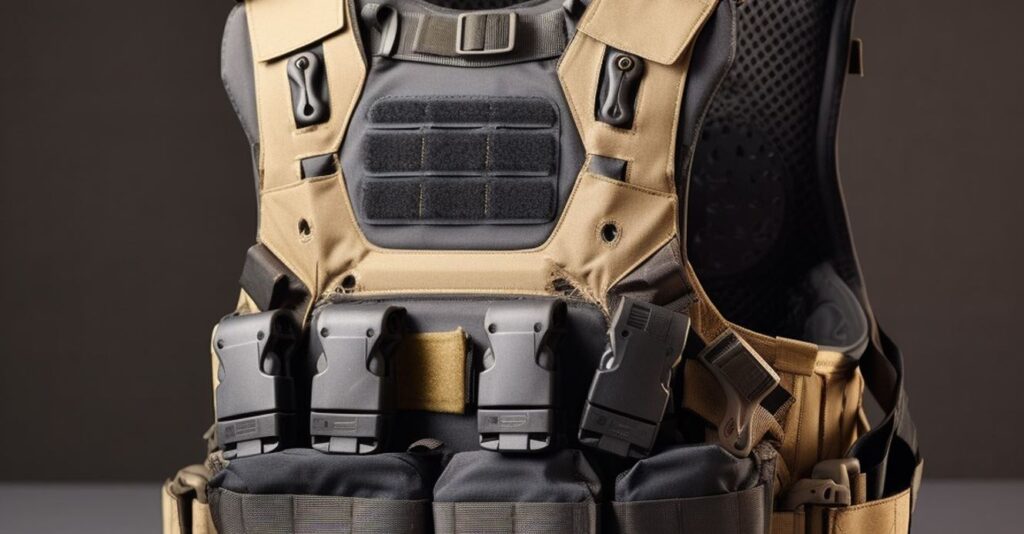
So, you’re curious about how bulletproof vests earn their stripes in safety, right? Well, they go through a gauntlet of tough tests before they can claim to shield your life. Test they undergo include:
- Threat Levels and Test Rounds: Vests face off against different levels of danger. They get shot at with specific ammo that matches real-world threats. From a .22 caliber for lower threats to a powerful .44 Magnum for higher levels, the vests have to show they can take a hit.
- Test Conditions: It’s like a science experiment but with higher stakes. Vests get shot multiple times, from various distances and angles, to mimic real-life scenarios.
- Performance Assessment: Here’s where it gets technical. This is a test to measure how much the bullet pushes into the vest, known as backface deformation. Vests pass only if they keep this dent within safe limits.
Bulletproof vests must meet or surpass the highest of standards set by the National Institute of Justice (NIJ), ensuring they can protect against specific levels of ballistic threats. To get the official thumbs-up, vests undergo a series of tests that simulate real-world conditions. This includes firing rounds at the vests from various angles and distances, with the aim of mimicking the types of ballistic threats one might encounter in the field.
The testing involves a round of bullets fired at the vest, testing its endurance and the consistency of protection it offers. The rounds used in testing correspond to the levels of protection the vests claim to provide. For instance, to meet the NIJ’s Level IIIA standards, a vest must stop .357 SIG and .44 Magnum rounds, which are typically used in handgun ammunition.
The conditions under which these tests are conducted are strictly controlled. A vest is subjected to a precise number of shots, spaced out at specific intervals, and fired from a fixed distance. The angle of the shots also comes into play during testing, as it can affect the vest’s ability to stop a bullet.
After being shot, the vest’s performance is assessed by measuring backface deformation—the dent left by the bullet on the inside of the vest. The NIJ has limits on how deep this dent can be, ensuring that the force of the impact should never cause serious harm to the wearer.
Here are a few key points to remember:
- Vests face off against realistic threats during testing.
- Test conditions are designed to mimic actual scenarios where a vest might be used.
- The backface deformation is measured to assess the vest’s level of protection.
Let’s look at the numbers and measurements used:
- Level IIIA vests are tested with .357 SIG FMJ Flat Nose (FN) bullets with a mass of 8.1 g (125 gr) and a velocity of 1,470 ft/s ± 30 ft/s, and with .44 Magnum Semi Jacketed Hollow Point (SJHP) bullets with a mass of 15.6 g (240 gr) and a velocity of 1,430 ft/s ± 30 ft/s.
- The maximum allowed backface deformation is 1.73 inches (44 mm).
Remember, a vest’s certification is your assurance that it will perform as expected in dangerous situations. So, when you’re browsing through our selection of body armor, you can trust that each piece has been put through the wringer to meet stringent safety standards.
As you learn more about the requirements for bulletproof vests, consider how these safeguards affect your safety. Isn’t it reassuring to know that the safeguard is based on such a meticulous procedure? Next, we will gradually transition to discussing the various certification levels that are available. Whether you’re preparing for high-threat situations or dealing with everyday risks, there’s a vest out there that’s perfect for you.
What Certification Levels Are Available for Bulletproof Vests?
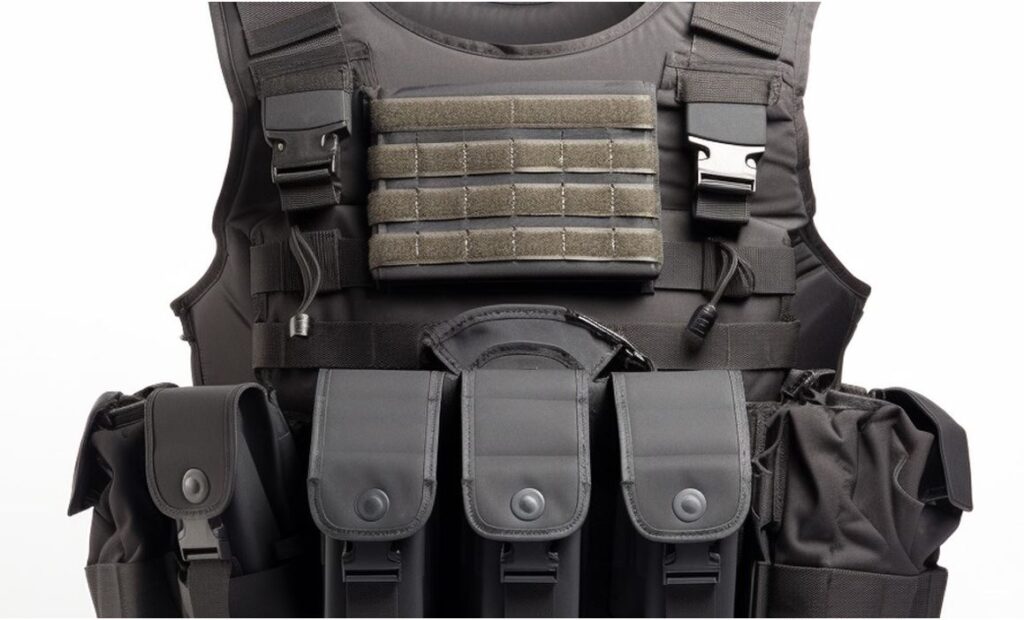
When you’re in the market for a bulletproof vest, understanding certification levels is key. Think of these levels as your assurance that the vest will stand up to specific threats. The National Institute of Justice (NIJ) sets standards that categorize vests by their protective capabilities. Here’s a breakdown:
- NIJ Level IIA: This level is designed to stop 9mm and .40 S&W ammunition. It’s recommended for everyday wear.
- NIJ Level II: Also stops 9mm and .40 S&W but provides additional protection against higher velocity rounds. Again, this is considered comfortable enough for everyday wear.
- NIJ Level IIIA: This level protects against most handgun threats, including 9mm, 40 S&W, and even .44 Magnum rounds. It’s a bit heavy but still manageable.
Making the best-informed choice can really come down to your daily activities. If you’re a civilian in a quiet town, a Level IIA might suffice. For those in law enforcement, a higher level is advisable. Always choose wisely, as your life could depend on it.
Bulletproof Vest Test Rounds Here’s a quick look at the types of ammunition each level is tested against. It’s a vital piece of knowledge for picking the right vest.
- Level IIA: Tested against 9mm Full Metal Jacket Round Nose (FMJ RN) bullets, with a mass of 124 grains and a speed of about 1,225 ft/s, and .40 S&W FMJ bullets, with a mass of 180 grains and a speed of 1,155 ft/s.
- Level II: Deals with 9mm FMJ RN bullets at a higher velocity of 1,305 ft/s and .357 Magnum Jacketed Soft Point (JSP) bullets, with a mass of 158 grains and a speed of 1,430 ft/s.
- Level IIIA: Stops .357 SIG FMJ Flat Nose (FN) bullets, with a mass of 125 grains and a speed of 1,470 ft/s, and .44 Magnum Semi-Jacketed Hollow Point (SJHP) bullets, with a mass of 240 grains and a speed of 1,430 ft/s.
Remember, the appropriate certification level can make a difference in various operational environments. For instance, law enforcement officers might need Level IIIA for maximum protection on duty.
| NIJ Level | Bullet Caliber | Bullet Type | Bullet Speed |
| Level IIA | 9mm & .40 S&W | FMJ RN & FMJ | ~1,225 ft/s |
| Level II | 9mm & .357 Mag | FMJ RN & JSP | ~1,430 ft/s |
| Level IIIA | .357 SIG & .44 Mag | FMJ FN & SJHP | ~1,470 ft/s |
It’s clear that the higher the NIJ level, the more formidable the bullet stopped. But remember, with increased protection often comes increased weight. Balance your need for safety with the practicality of wearing the vest for extended periods.
In the quest for the right vest, it’s not just about stopping power. Comfort matters too. After all, what good is a vest if it’s too cumbersome to wear when danger strikes? Our bulletproof vest at the Bullet Proof Supply Store offers Level IIIA protection in a design that’s both concealable and comfortable. Plus, with free size exchanges for 30 days, you can be certain of a perfect fit.
Regular maintenance and follow-up inspections are crucial. After all, you want your vest to be as ready as you are, should a threat arise. Keep an eye on the condition of your protective gear, and don’t hesitate to replace it if it shows signs of wear or damage. Your safety is worth the investment.
The Role of Follow-Up Inspections and Quality Control
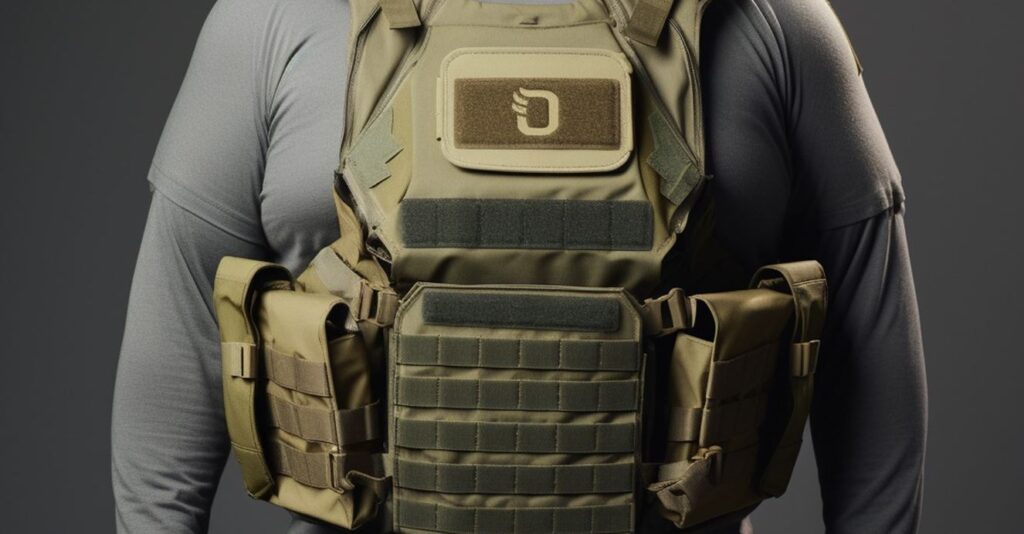
Once a bulletproof vest passes its initial tests, it’s not the end of the road for ensuring safety. Regular follow-up inspections keep the vests up to par. These inspections can ensure your vest lasts for long periods of time, not just on day one.
- Follow-up inspections happen often. They check that all vests still meet the safety standards set by organizations like the National Institute of Justice (NIJ).
- Quality control isn’t just a one-time thing. Regular inspections can make sure vests stay strong and protective for as long as needed.
- If a vest fails during these checks, it’s a big deal. Potentially the vest won’t protect as intended, which can have serious consequences.
Imagine this: You’ve got a vest that’s been your trusty sidekick for a while. But after time, it fails an inspection. That’s not just a minor hiccup. It means you may need a replacement to ensure your safety.
Here’s a quick look at what happens if a vest doesn’t make the cut during these follow ups:
| Outcome of Failed Inspection | Action Taken |
| Vest degradation | Review and possible replacement |
| Non-compliance with standards | Mandatory correction or disposal |
| Safety risk identified | Immediate withdrawal from use |
Remember, these vests are lifesavers. They need to be always top-notch. That’s where the follow-ups and quality control come in, making sure every layer, stitch, and strap is ready to do its job.
Pro Tip: Check out the detailed standards and tests vests go through at resources like the NIJ’s body armor performance standards or the PDF on ballistic resistance of body armor.
Now, let’s say you’ve got a vest. Here are some things you should know:
- Vests are made to be tough, but even they have limits.
- It is critical to maintain your equipment. Maintaining and stowing things correctly are essential.
- Always check the vest’s expiration date. Yes, they do expire.
It’s like having a car – you wouldn’t skip your oil change, right? The same goes for your vest. Regular check-ups are a must.
Different places have their own rules, but they all aim for one thing: keeping you safe. The specifics might change, but the goal stays the same. Always look for gear that’s been put through its paces, no matter where in the world it comes from.
International Standards Versus NIJ Standards
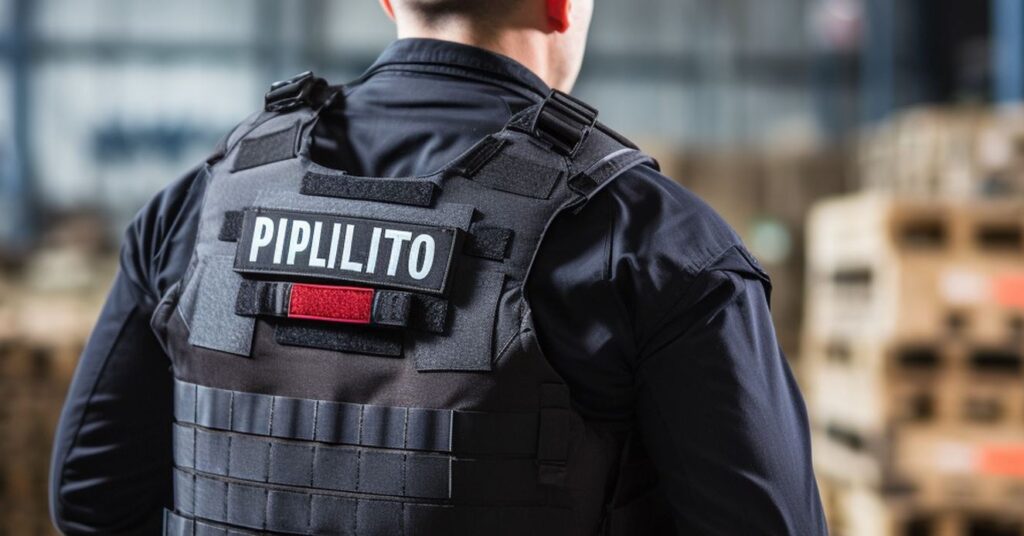
When it comes to bulletproof vest testing, the National Institute of Justice (NIJ) standards in the United States often come to mind. Yet, other countries have their own standards, which can be confusing for those investing in body armor. Let’s demystify these standards and their significance.
- NIJ standards are the U.S. benchmarks for body armor. They’re thorough and well respected worldwide. But across the pond, the European Union has its own set of criteria, often referred to as the EN standards. ISO, a global federation, also chimes in with its specifications. Each has its own merits, but how do they compare to one another?
- In essence, all these standards aim to ensure a vest can withstand specific threats. Yet, how they test and what they consider acceptable can vary. The NIJ, for instance, includes a blunt trauma protection requirement, which isn’t always the case with other standards.
- For manufacturers, these differences mean tailoring products to meet diverse certifications – a complex dance indeed. Users, meanwhile, must navigate which standard suits their needs, often pondering over the fine print.
In this intricate realm of bulletproof vest testing, here’s a peek at how these standards compare:
| Standard Issuing Body | Blunt Trauma Test Ammunition | Protection |
| NIJ (National Institute of Justice) | Specific calibers including .44 Magnum and 9mm | Required |
| EN (European Union) | Varied, including 9mm Parabellum | Not always required |
| ISO (International Organization for Standardization) | Depends on the specific ISO | Varies standard |
Browsing through the Bullet Proof Supply Store, you might wonder about the protection levels of the vests on offer. How do these compare with international standards?
Here’s a brief rundown of what to keep in mind:
- NIJ Standards: Renowned for their strict testing protocols. They offer assurances that a vest can stop a variety of threats and assess the impact force delivered to the body.
- International Standards: These may focus more on the vest’s ability to prevent penetration rather than blunt trauma. In some instances, they may also test against different ammunition types.
- User Considerations: Depending on where you’re located or where you’ll be using the vest, one standard might be more relevant to you than another.
Let’s not forget, the NIJ revises its standards periodically, adapting to new threats and technology. For instance, the NIJ Standard-0101.06 is the current benchmark for ballistic resistance. This standard requires thorough testing, including environmental conditioning and impact testing through different angles.
Anyone wanting to find out more details, check out NIJ’s own documentation offers a wealth of information. It lays out everything from testing procedures to the nuances of different armor levels.
Now, if you’re considering a bulletproof vest, the stats speak for themselves. According to the NIJ, in their 2020 report, over 3,000 lives have been saved by wearing NIJcompliant body armor. That’s a compelling argument for sticking with these standards.
Always remember that the right choice hinges on your unique scenario. Think about the threats you’re likely to face and the standards most pertinent to your region. With a clear understanding, you’re better equipped to choose armor that meets your safety needs.
Conclusion
We’ve discovered together the in-depth details of bulletproof vest standards and testing. It’s clear as day why this stuff matters a ton. Our gear must meet the mark every single time. At Bullet Proof Supply Store, we’re not just selling vests. Nope, we’re in the business of peace of mind. And that peace of mind comes from knowing you’re shielded by gear that’s up to snuff on all the tough standards. We’ve got your back, and we’re not just saying it – we’re proving it with the kind of armor that can take a hit and keep on ticking.
Key Takeaway
Remember, when you’re in the market for armor that won’t let you down, think of us. Our vests have been put through the wringer, so you won’t have to. They’re tested, trusted, and ready to serve. So, if you’re ready to step up your safety game, reach out. We’ve got a form right at your fingertips in the footer – “Contact Us” – waiting for your buzz. Drop us a line, and let’s get you suited up in armor that’s as reliable as the morning sun.
Frequently Asked Questions about Understanding – Bulletproof Vest Testing and Certification Standards
What are the main certification standards for bulletproof vests?
Certification standards for bulletproof vests vary by country and organization, but the most widely recognized standards include the National Institute of Justice (NIJ) standards in the United States, which are considered the benchmark for ballistic resistance of body armor. The NIJ categorizes vests into different levels such as Level II, IIA, III, IIIA, IV, based on their ability to stop specific types of bullets at various velocities. Other standards include the German Schutzklasse, UK Home Office Body Armour Standards, and the ISO 14876 international standard.
How is the NIJ ballistic resistance standard structured?
The NIJ ballistic resistance standard is structured into several levels of protection, with each level detailing the type of ammunition it can protect against and the speed at which the vest can stop the bullet. For example, Level II armor is tested to stop 9mm and .357 Magnum ammunition, while Level IV armor can stop armor-piercing rifle rounds. Each level has specific test protocols that include shooting the vest at defined velocities and distances, with a particular number of hits in specific patterns.
What is the process of testing bulletproof vests?
Testing bulletproof vests usually involves a series of controlled laboratory tests. The vest is mounted on a mannequin-like torso and subjected to gunfire with specific ammunition based on the certification standard it’s being tested for. The vest is shot at predetermined locations and angles, and its performance is assessed based on the depth of the indentation on the clay backing material behind the vest (backface signature) and whether any penetration occurred.
To what extent does the backface signature matter when evaluating vests?
The backface signature is the depth of the indentation made in the clay backing material behind the vest after a bullet impact. It is crucial because it indicates the amount of blunt force trauma a wearer might experience, even if the bullet does not penetrate the vest. Certification standards have maximum allowed backface signature depths to ensure that the vest not only stops the projectile but also sufficiently disperses the energy to reduce the risk of serious injury.
Can a bulletproof vest be certified after being exposed to environmental conditions?
Yes, bulletproof vests can be certified after being exposed to environmental conditions. The NIJ, for instance, includes environmental conditioning in its test protocol. Vests are tested under conditions like temperature extremes, moisture, and mechanical wear to simulate the wear and tear that occurs over time. They must still meet performance standards after this conditioning to be certified.
What is the difference between a bulletproof vest’s “warranty” and “service life”?
The “warranty” of a bulletproof vest is the period during which the manufacturer guarantees the vest’s performance and quality. The “service life” is the expected period during which the vest is considered to remain functional and provide the rated level of protection, which may be affected by factors like usage, care, and maintenance. Vests should be inspected regularly and replaced if they show signs of damage or if they’ve reached the end of their service life.
How often should bulletproof vests be replaced?
The frequency at which bulletproof vests should be replaced depends on the manufacturer’s warranty and service life recommendations. Typically, the service life of a vest may range from 5 to 10 years. However, vests should be inspected frequently— ideally before each use—and replaced immediately if they are damaged or have been subjected to a ballistic event.
Are bulletproof vests tested for stab or spike resistance?
Bulletproof vests are primarily tested for ballistic resistance. However, some vests are also designed and tested for stab or spike resistance, which is a different type of protection. Separate standards, such as the NIJ’s Standard-0115.00 for stab resistance, exist for this purpose. Vests that offer dual protection will have been tested and certified under both ballistic and stab/spike resistance standards.
Do all bulletproof vests meet the same certification standards?
No, not all bulletproof vests meet the same certification standards because different countries and regions have their own standards and testing protocols. Manufacturers may choose to meet one or more of these standards. It is essential for users to understand the specific threats they face and select a vest that is certified to protect against those threats.
How do users know if a bulletproof vest meets certification standards?
Users can verify if a bulletproof vest meets certification standards by checking for the label or documentation that comes with the vest. This should include information about the level of protection, the testing standard it adheres to, and the certification it has received. Additionally, most recognized standards require that certified products be listed in an official database or on a website, where users can confirm the vest’s certification status.

